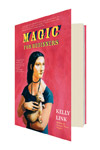Some writers make the mundane bizarre. Others make the bizarre mundane. Kelly Link levels the playing field. You can take her casually enchanted tales literally, or you can read them as allegory; the effect is equally unnerving. One of Link’s new stories, “The Hortlak,” in which zombies frequent a twenty-four-hour convenience store, casts a fluorescent glare on the shopping habits of the undead and the hallucinatory tedium of working retail. In “Stone Animals,” the contents of a middle-class family’s new suburban home gradually become “haunted”—a condition no less (or more) explicable than the rabbit infestation on their lawn or the nagging stresses and resentments of their daily existence.
Link’s second collection, Magic for Beginners, is modestly titled; it’s more like a workshop in advanced alchemy, cumulatively weirder and wiser than her delightful 2001 debut, Stranger Things Happen. Her best stories (and there are at least three small masterpieces here) are breathtaking tightrope acts—at once faintly familiar and pungently defamiliarized, thick with incongruous detail yet clouded in a redolent ambiguity. They are not merely dreamlike—subject to an intricate internal logic, they have a pulsing, worrying intensity, a larger meaning that lies just on the outer limits of apprehension, like dreams transcribed on the verge of consciousness.
As in all fantasy fiction, rules rule, and Link affects an irresistibly cool, semiparodic nonchalance in laying out the physical and metaphysical laws of her worlds: “The zombies were like Canadians, in that they looked enough like real people at first, to fool you.” Her restrained and deceptively placid prose makes the occasional enigmatic intrusion of the first-person truly eerie. She’s sparing with adjectives, but given to glorious, leaping analogies: “Charley looked like someone from a Greek play, Electra, or Cassandra. She looked like someone had just set her favorite city on fire.”
Corralled together, Link’s characters would make quite a Halloween parade float: spurned ghosts, spiteful witches, heroic librarians, sympathetic kleptomaniacs, estranged spouses, absent parents, alienated kids, a dog-killing girl, a witch-killing cat, the devil, and a cheerleader. For all the fanciful unexplained phenomena, the thing to fear most is time—alternately referred to as Time—which slows down, speeds up, or runs backward, but is always scary and what many of the characters are fleeing from. These stories are forever wondering what lies beyond or inside or beneath. The most important actions involve passing through mysterious doors, tunneling down passageways, slipping on—and off—second skins.
The stories likewise continually don and shed off unexpected layers: “Lull” begins at a poker game and segues—via an impromptu call to a phone-sex line described as “Stephen King and sci-fi and the Arabian Nights and Penthouse Letters all at once”—to a teenager’s heart-to-heart with the devil in a reverse-unspooling universe, where she will eventually be unborn and he will be good again. It’s inadequate to simply call this palindromic suite (which later brackets a couple more stories on cloning, time machines, and green beer) metafictional. In this infinite feedback loop, as violent and slippery a reverie as Mulholland Drive, time is alarmingly elastic, viral narratives feed off each other, and the accruing sense of sorrow is nothing less than cosmic.
More straightforward but no less ingenious in its nested architecture, the title story interpolates Buffy into Dawson’s Creek, and is even more heartbreakingly perfect than that sounds. Link imagines her way into a TV show called The Library, a teen drama whose cute, hormonal, conspicuously quotable friends are devoted fans of a TV show called The Library, a paranormal, ass-kicking series of mysterious provenance that pops up without warning at ungodly hours on random cable stations (not unlike the addictive internet footage in William Gibson’s Pattern Recognition). The hero, Jeremy, is a sentient TV character, obsessed with Fox, a character on the show-





